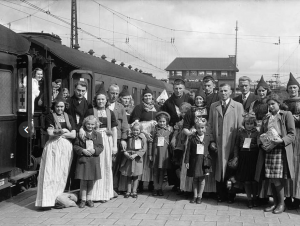Loading...
The Kindertransport, a remarkable humanitarian effort that unfolded during World War II, played a vital role in rescuing nearly 10,000 predominantly Jewish children from the clutches of Nazi persecution. Let’s delve into the history of the Kindertransport, highlighting its significance as an act of compassion and providing insights into its enduring impact.

-
- The Origins of the Kindertransport: The Kindertransport initiative emerged in 1938 as a response to the escalating persecution of Jewish people by the Nazi regime. Fearing for their children’s lives, families in Germany, Austria, Czechoslovakia, and Poland made the heart-wrenching decision to send their little ones to safety in the United Kingdom.
- The Logistics of the Rescue Operation: Coordinated by various organizations, including the British Committee for the Jews of Germany and Austria, the Kindertransport involved intricate logistics. Trains carried the children across borders, and upon arrival in the UK, they were temporarily housed in reception camps before being placed with foster families, religious institutions, or hostels.
- The Impact on Families: While the Kindertransport offered a lifeline to the children, it came at an immense cost for their families. Parents had to bid farewell to their beloved sons and daughters, often with the knowledge that they might never see them again. The emotional toll and the enduring pain of separation created lifelong scars.
- The Reception in the United Kingdom: The British government and citizens demonstrated remarkable generosity and empathy towards the Kindertransport children. Many families opened their homes, providing a safe haven for these young refugees. Religious institutions and hostels also played a crucial role in offering support and care.
- Challenges and Adjustments: The Kindertransport children faced numerous challenges as they adapted to a new country, language, and culture. Despite these obstacles, many children went on to rebuild their lives successfully, assimilating into British society and making significant contributions to their adopted homeland.
- Legacy and Remembering the Kindertransport: The Kindertransport’s legacy is multifaceted. While it rescued thousands of children from the horrors of the Holocaust, it also symbolizes the heart-wrenching separation and loss experienced by families during that dark period. Commemorative events and memorials serve as reminders of this pivotal chapter in history.
Loading…
- Lessons for Today: The Kindertransport teaches us enduring lessons about compassion, empathy, and the importance of offering refuge to those fleeing persecution. It stands as a poignant reminder of the humanitarian spirit that can triumph over adversity, inspiring us to extend our hand to those in need.
The Kindertransport remains a testament to human resilience and the power of collective action. By rescuing thousands of Jewish children during World War II, it offered hope and a chance for a better future. Today, as we reflect on this extraordinary rescue effort, may we carry forward its lessons of compassion and embrace the responsibility to protect and support those facing similar challenges in our world.
Cite This Article
"Kindertransport: A Tale of Hope and Rescue during World War II" History on the Net© 2000-2024, Salem Media.
May 3, 2024 <https://www.historyonthenet.com/kindertransport-a-tale-of-hope-and-rescue-during-world-war-ii>
More Citation Information.





